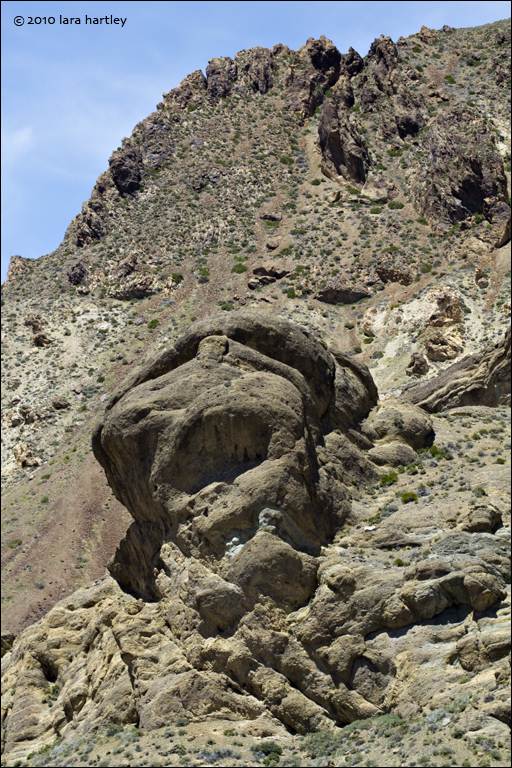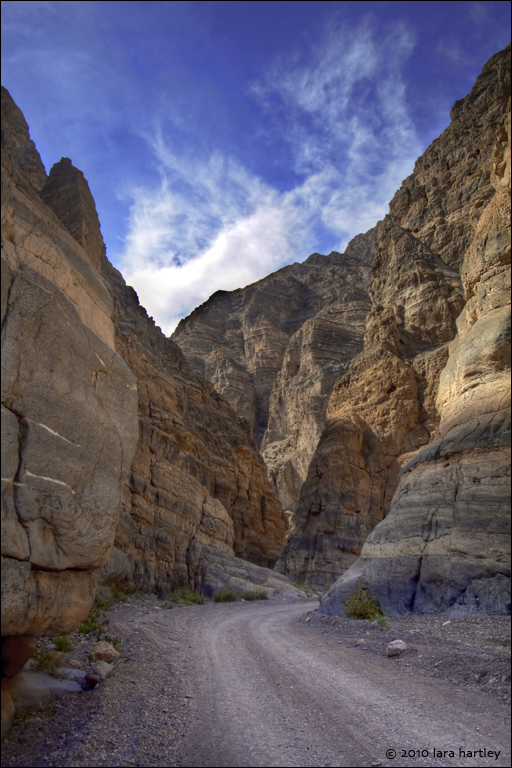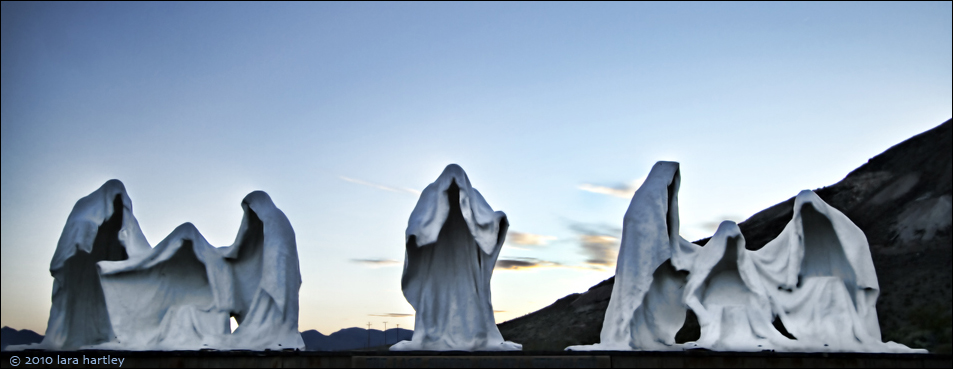
Beware the rock goblins that lurk in the mountains around Titus Canyon. The road can be treacherous if you spend too much time gaping at super-sized stone gargoyles and goblins. Trek carefully past the guardians of Red Pass, and the gravel washboard road leading to Titus Canyon’s steep-walled limestone cliffs will take you through some amazing, absolutely breathtaking, scenery.
Titus Canyon is the most traveled back road in Death Valley, and on my Saturday visit I saw 10 to 12 cars on the entire 27-mile trek.
On Sunday’s visit I saw three. Not exactly traffic jams.
I was going to see some rare wildflowers, which should not surprise those of you who regularly read my columns. With good intel I was pretty sure what I wanted to see would still be in bloom. What I was not prepared for was the abundance of flowers all down the road. It was a veritable wildflower garden out there with dozens of species. Desert larkspur, little white daisies, big yellow daisies and tall prince’s plume put on a memorable show.
While I was hanging out in the desert taking flower pics I could see headlights coming down the one-way road off in the distance. Each time I stopped I made sure my car was well out of the way. During one stop a small queue of cars approached. I kept a wary eye on the road and kept on shooting. The lead car pulled up, the driver stuck his head out the window and yelled, “Hey Lara!”


Can you imagine my surprise!? I looked closely at the guy and sure enough, I knew him — Internet handle “B-Spec” — from a Web forum called “Panamint Valley” — a group of like-minded desert lovers who have regular get-togethers in and about Death and Panamint valleys. I asked him how the heck he knew it was me standing out in the desert. He said he saw Walter-the-Car first, recognized her, looked around and saw me. He was leading a short auto tour down Titus Canyon.
Another one of those “it’s a small world” moments. I mean, how weird is that in the middle of nowhere? Walter-the-Car is famous.
I spent too much time hopping in and out of the car, dragging my weighty camera gear and tripod around and was getting pooped, so I decided I’d better head on down the road to my rare flowers’ locations.
I passed by Leadfield and thought there wasn’t enough “stuff” there to warrant a stop that afternoon. I would hit Leadfield another day.
I found both species of the rare plants I was seeking (Maurandya petrophila, rock lady and Arctomecon merriamii, desert bear poppy) and the exotic-looking stream orchid (Epipactis gigantea).



Orchids in Death Valley, who would have thought it. Klare Spring provides the perfect environment for the orchid.
I envision all sorts of critters enjoy that little oasis with abundant cattails and grasses, and indeed it is a critical water source for the desert bighorn sheep. The water even meanders across the gravel road and sinks into the grey sand.
At the end of the canyon, I hopped on the highway back to Beatty but first stopped at the spectacular ghost town of Rhyolite and the Goldwell Open Air Museum.


Just outside of Rhyolite a group of prominent Belgian artists, led by the late Albert Szukalski, created a self-described art situation consisting of seven outdoor sculptures that are colossal not only in their scale, but in their placement within the immense upper Mojave desert.

I wanted to see the life-size sculptures by Szukalski depicting Da Vinci’s Last Supper. As the sun was going down behind the mountains, the art took on a ghostly glow. I thought no matter what one’s spiritual outlook on life, these statues were oddly at home and at peace in the vast desert sunset, as was I.

Finis
More Information:
Titus Canyon Road
- Vehicle needed: Two-wheel-drive, high-clearance recommended; four-wheel-drive may be needed after adverse weather conditions. Two-way section from west OK for two-wheel-drive, standard clearance vehicles.
- Distance: 27 miles; last 3 miles on west end are two-way
- Time needed: 2 to 3 hours
- Start: Nevada Highway 374 (Daylight Pass Road), 2 miles east of park boundary Road
- Conditions: One-way road from east; this dirt road is rough, steep and narrow; often closed due to snow, mud, or wash outs; two-way section from west is graded dirt road.
- Warnings: Infrequently patrolled, summer travel not advised. Canyon prone to flash flooding, avoid entering when rain threatens. Ask at ranger stations for current road and weather conditions.
Titus Canyon
Click here to watch a video of a drive through Titus Canyon.
Click here to read more about Titus Canyon.
Panamint Valley
panamintvalley.com/forum/index.php
Piercing the Heart of the Panamints Via Goler Canyon
Goldwell Open Air Museum
The sculpture park is free and open to the public 24/7. Click here to watch a video about the Goldwell Art Museum.
For Albert Szukalski, “America” and “The West” represented a place of ultimate freedom where he had permission to pursue his artistic vision unfettered by historical precedent or convention.
Source: www.goldwellmuseum.org/artists/index.html
With new artist residency and artist workspace programs offered in the nearby Red Barn Art Center, Goldwell remains the kind of place for those who seek adventure in their art making in a marvelous and challenging landscape.




Reminds me of the last time I was there in early June. Just as beautiful as ever…
We love the Titus drive, but have missed seeing the rock goblins. Which month would be best to see the wild flowers? Looking forward to our next trip to Death Valley.
I just left CA to return to my home in Costa rica but hope that if I visit next year I can see Titus Canyon & get another look at Death Valley 30 years later. Wonderful photos, good information & although I live in a lovely little corner of the tropics I would love to visit my second love of the outdoors, CA deserts, in Sept & Oct when our rainy season makes us want to take a break. I went to 1st grade in 29 Palms in 1952 & walking out to catch the bus I would crawl along with big desert tortoises on occasion. The colors were a special part of my 6th year of life & I learned that scorpions don’t want to mess with humans. That knowledge has been useful in Costa Rica.
I have had the good fortune to have been in Death Valley since 1969. Many times each year, and during the 4 seasons. Titus is one of my favorite canyons. Also Trail Canyon before the flood that closed it. I have pictures that are treasures. The flowers in the “big bloom” years are outstanding. Love the rock formations, and even the salt flats.
Wow – this was a great article and fantastic photos.
Another informative and interesting piece, with some of the pictures saying more than words ever can.
I can relate and synpathise to some degree with the derelict Rhyolite buildings in need of restoration.
We have a number of buildings that are ‘Listed’ or have Architectural or Historical interest, but funding, whether locally or via Historic Scotland, is limited, non-existant, or ‘priority’ dependant.
The counter-argument is they tell more of a story or are more ‘poignant’ left as is…
I wish I made it there last spring. These articles made me want to chuck it all and take a nice long road trip.
I have been wanting to go back Death Valley for years. Now I have Titus Canyon on my list!
Wow. Just wow.
Back east here everything is thick and green, overhanging branches turning the Sudbury river bridge (of “over the river and through the woods” fame) into a cool leafy tunnel. The river itself is choked with algae, snapping turtles, and improbably-colored frogs. Vicious gangs of mosquitoes lie in wait for the unwary; come twilight, they rule the night. The hazy, hot, humid air coats the skin like Vaseline making every love affair long distance: “I love you. Don’t touch me.”
And I’m hiding in the air conditioning, dreaming of some dry desert air.
Ahhhh…another great desert story. I miss the dez since moving to Oregon in 2005, thanks for refreshing my memories on it’s start, yet striking beauty.
Great photographs and engaging article by Lara. Makes me want to go there next spring. Thank you!